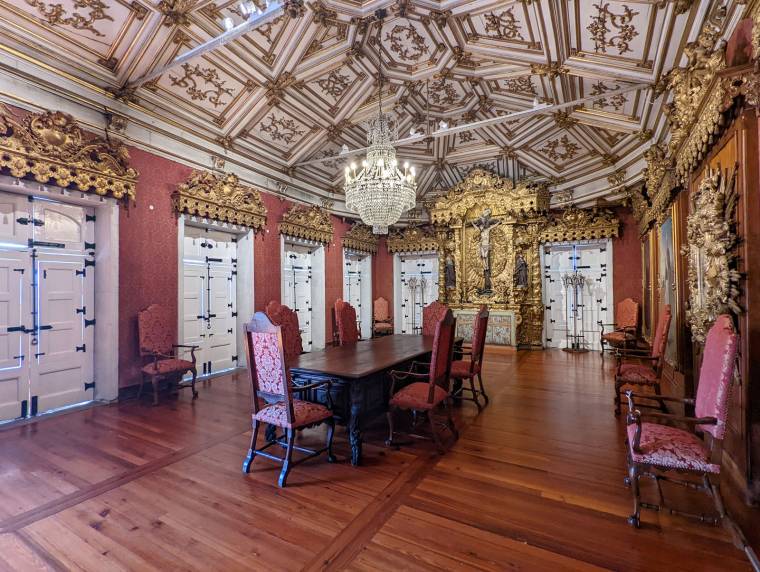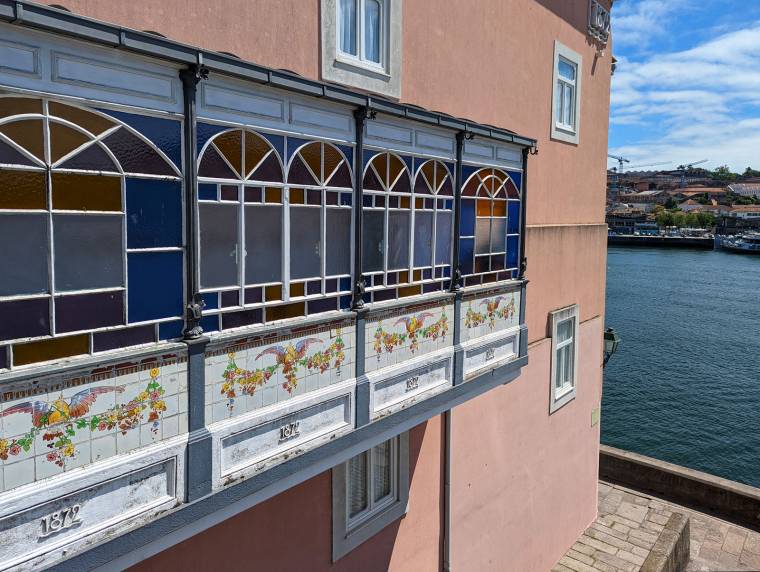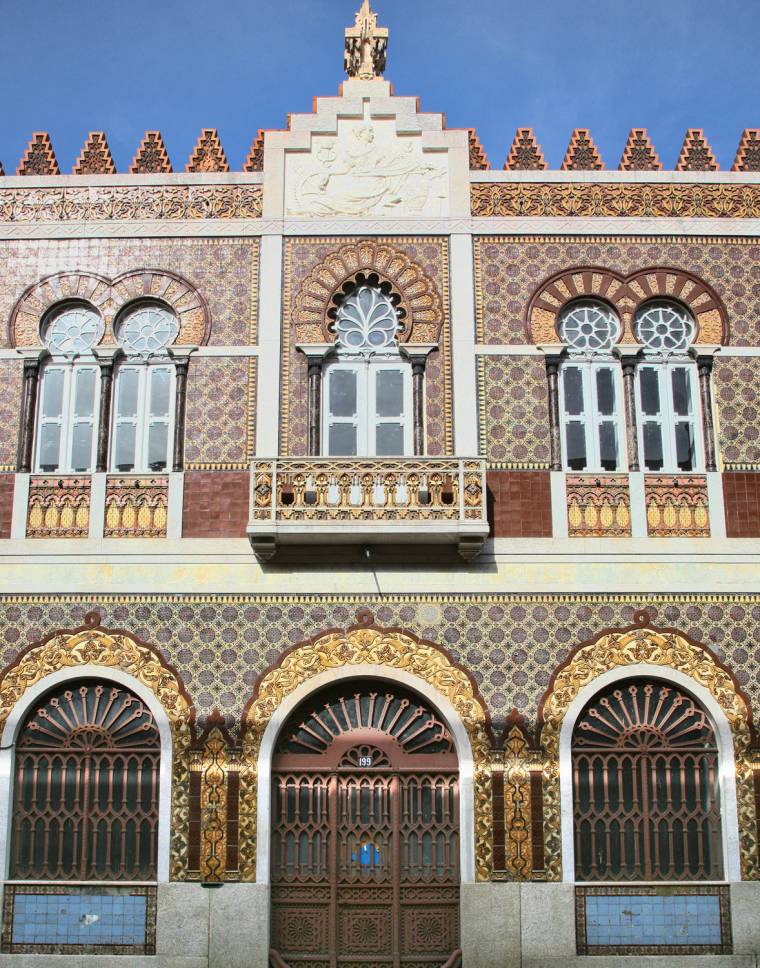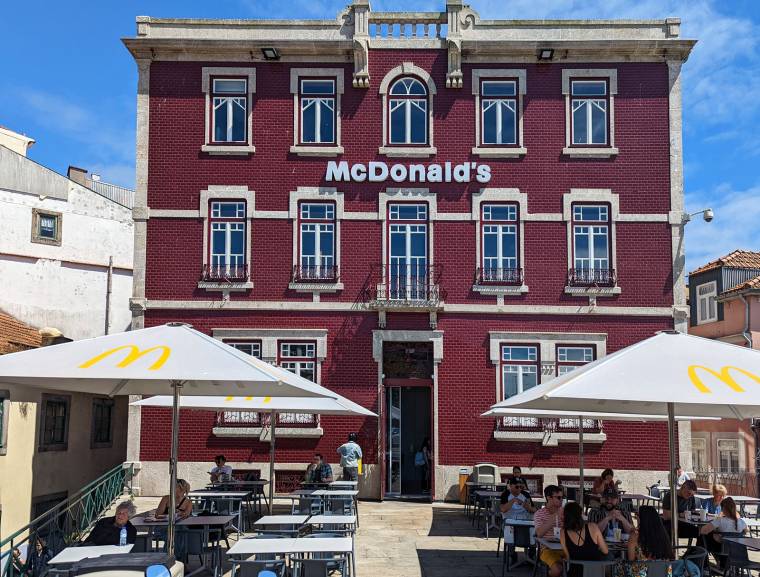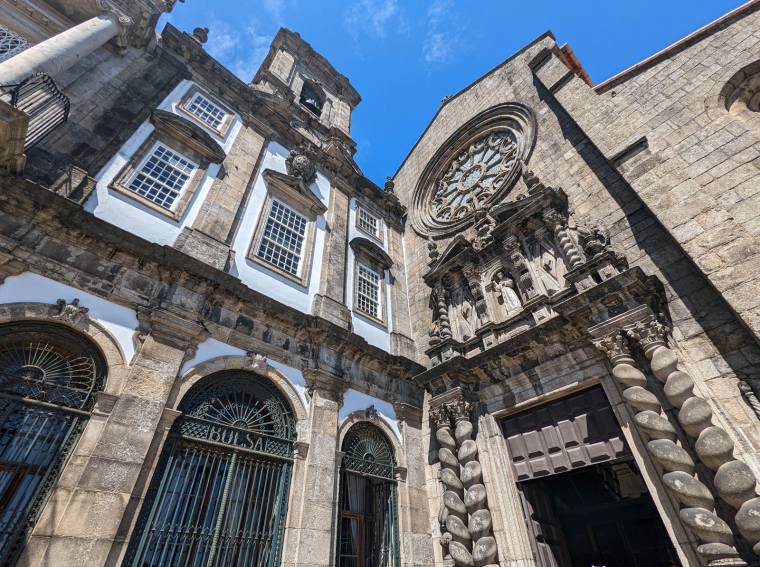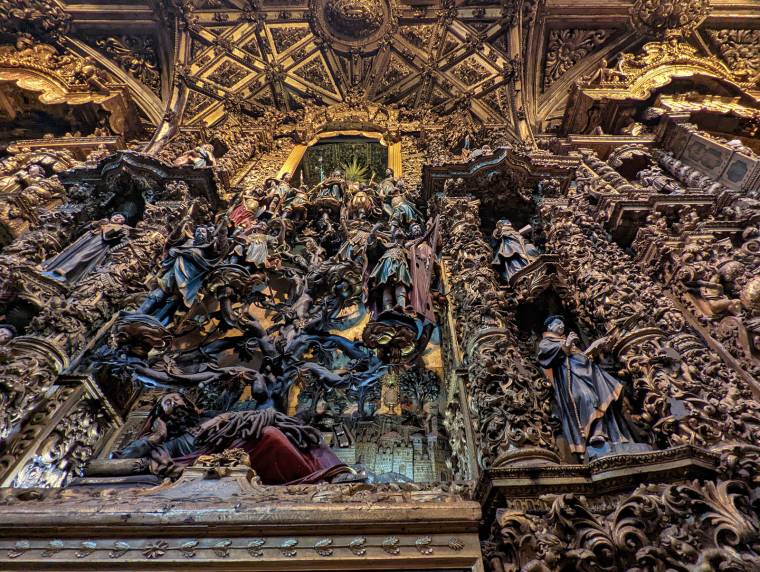This is the Session Room in the Dispatch House of the Order of São Francisco in Porto. It is in the same building as the Catacombs which dates back to the mid-18th century.Despite much of the church having been deconsecrated the board of the Venerable Order of Saint Francis still meets in this room.It is an impressive room for a number of reasons, not least the ceiling. Dating back to 1748 it was created by the master José Martins Tinoco, according to a design by architect Nicolau Nasoni who also designed the rest of the building.The near life-size portraits in oil on the wall are of monarchs D. José and D. Mariana Vitória. However the true masterpiece is the altarpiece created by José Teixeira Guimarães in sumptuous gold-gilt. The Brazilian rosewood table is also his work.
Related images
Now a guest house, the 1872 House on Porto's riverside most likely long predates its current name. Sitting just across the road from the Igreja de São Francisco and next door to McDonald's the coloured glass of this passageway has become quite iconic. There is a door at the end of the structure that was presumably added to give access from street level on Rua do Infante D. Henrique.
Related images
Whilst the exterior of the Igreja de São Francisco in Porto is a fine example of Gothic architecture it is the outstanding Baroque inner decoration for which this church is best known.It is estimated that between 300 and 500 kg of gold were used on the exquisite gold-gilt wood carving which covers much of the church's interior. The majority of the intricate decor was added during the 18th century. As far as I can gather the level of opulence displayed did not sit that well with the conditions endured by the poor of Porto and the church was considered something of an embarrassment by many.
Related images
A nod to Portugal's Moorish heritage on Rua de José Falcão in Porto. The building dates back to 1899 and it is no accident that it is covered in particularly fine azulejos tiles. Originally this was a showroom and warehouse for the Devesas ceramics factory, situated in Vila Nova de Gaia.As far as I know the building was home to a restaurant until relatively recently but has since become office space.
Related images
McDonald's in Porto city centre is often cited as the most "beautiful" of all its near 40,000 locations throughout the world. Situated in the old Cafe Imperial this site is a wonderful example of Art Deco architecture both inside and out.The cafe became a McDonald's back in 1995 and thankfully virtually all its period features have been retained. Inside the building is some wonderful stained glass and a sizeable crystal chandelier.The most notable feature though remains the bronze eagle sculpture above the entrance. This was created by sculptor Henrique Moreira.
Related images
Occupying a prime position on Porto's riverside between the Ribeira and Alfândega is this McDonald's. This isn't quite as iconic as the other McDonald's in Porto on Avenida dos Aliados which is set in the Art Deco Imperial Cafe, but it is still a fine building, with arguably a better location.
Related images
The interior of the Igreja da Venerável Ordem Terceira de São Francisco (Church of the Venerable Third Order of São Francisco). This church sites between the better known Church of São Francisco and the House of Dispatch.The church was built at the end of the 18th century in a Classical style, which was something of a departure from the Baroque which had become more or less ubiquitous at during the 1700s.The interior we see here is fairly ostentatious by most people's standards, but compared to the church next door it is fairly restrained.
Related images
The Gothic entrance to the Igreja de São Francisco next to the Baroque facade of part of the Palacio do Bolsa. All this was once part of a Franciscan monastery but with the 1834 Dissolution of the monasteries act the church was deconsecrated - and actually used as a warehouse.Work commenced on the adjoining Bolsa Palace (stock market building) around this time with parts of the church being incorporated. If you look at the green metal grille on the centre window you will notice it has 'BOLSA' on it.
Related images
A closer look at a small part of the decor that covers the interior of the Igreja de São Francisco in Porto. Perhaps the most opulent church in Portugal, the Gothic building dates back to the 13th century. However the interior is somewhat more recent and was part of an early Baroque remodeling in the 18th century.It is said the interior is decorated with up to 500 Kg of gold in the form of gold gilt wood carvings. Looking at this small section, particularly higher up, it wouldn't be surprising if this turned out to be a conservative estimate.As far as I am aware the church was deconsecrated many years ago. This was partly due to embarassment about the indulgent decor given how much poverty surrounded the church.
Related images
I think the term ossuary somewhat flatters what we see here in the São Francisco Catacombs in Porto. This is more of a bone pit which looks like it has been cremated at least once.This is where many of the hoi-polloi of Porto were interred, unlike their wealthier neighbours who had family tombs. This rather macabre scene can be viewed through a grill in the floor in the catacombs - it is something of a contrast to the sumptuous gold-gilded interior of São Francisco church next door.
